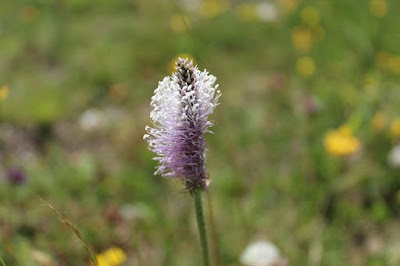Bristly Oxtongue (Helminthotheca echioides) is a rare plant in the county with only 2 dots on the BSBI map but at Pegswood Moor I have come across over a hundred plants growing around the lake. Presumably the plants have arrived via wild flower seed. During June and early July the site was very colourful with a huge acreage of Clovers and Trefoils. This gave good counts of insects with over a hundred Burnet and Shaded Broad-bar moths. The highlight was the number of Common Blue butterflies with 83 counted here on 18th June. Good numbers of Ringlet and Meadow Brown more recently and a few Large Skippers.
Peigh Hills Ponds and below Robinhood wood pond on the former opencast site at Stobswood.
At Stobswood former opencast the wet areas of this site are looking good for wildlife and already a number of wetland species are established here. Broad Bean (Vicia faba) was a more unusual find at East Stobswood.
Back at Pegswood Moor and a colourful meadow. Most of the Knapweed (Centauria nigra) flowers are of the rayed form and tall grasses of Timothy (Phleum pratense), Chicory (Cichorium intybus) and Hoary Plantain (Plantago media).






























